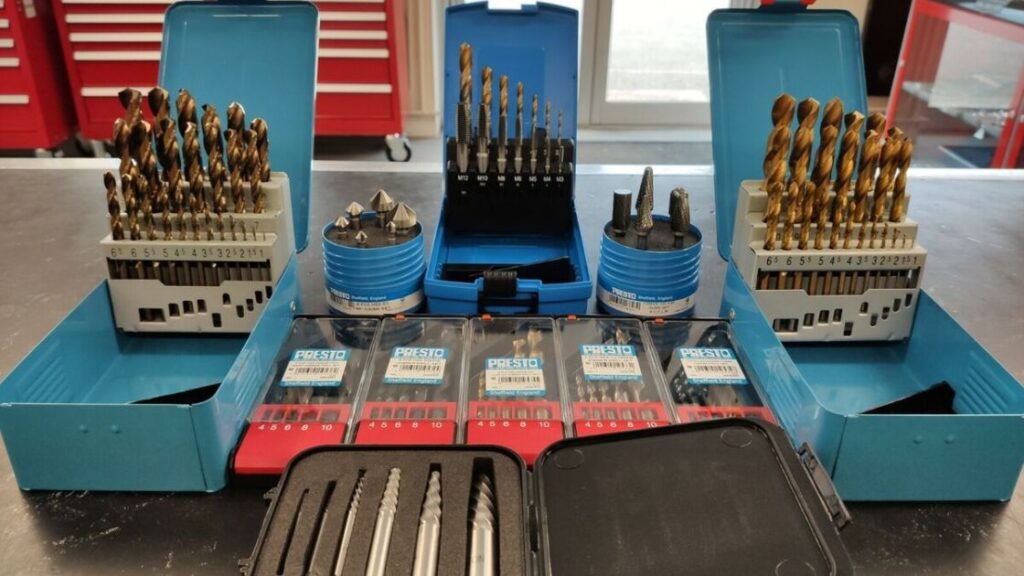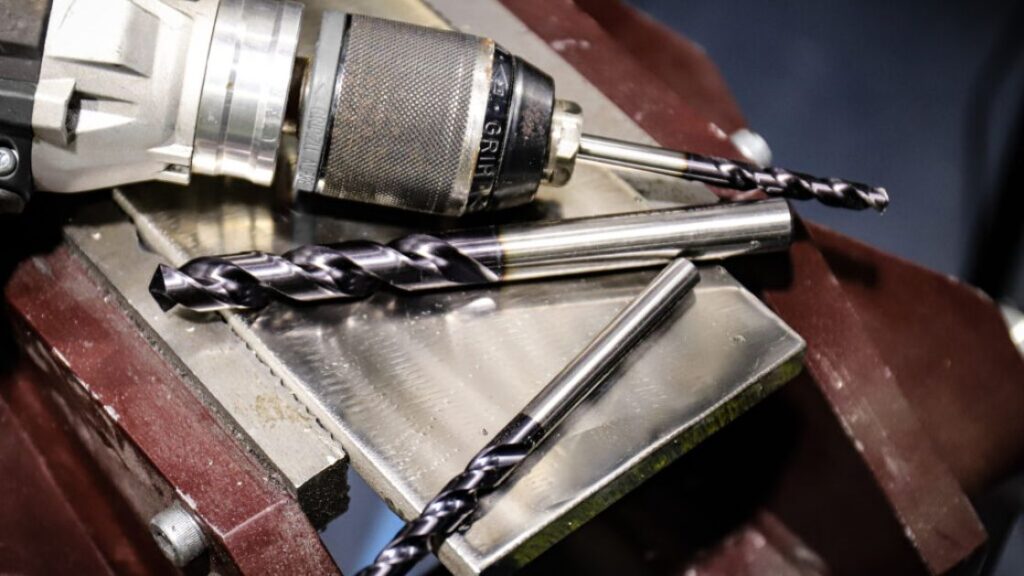I’ll be real with you—drilling into stainless steel is no joke. The first time I tried, I burned through two cheap drill bits and barely made a dent. I felt frustrated and defeated. Stainless steel is hard, slippery, and it heats up fast. But once I figured out what drill bits actually worked, everything changed.
In this guide, I’m going to walk you through exactly what I learned—what are the best drill bits for stainless steel, how to use them right, and which ones to avoid like the plague. Whether you’re a weekend DIYer or just need to drill one clean hole, I’ve got you covered.
Article Summary
- What Are the Best Drill Bits for Stainless Steel?
- Why Is Stainless Steel So Hard to Drill?
- Types of Drill Bits for Stainless Steel (With Pros & Cons)
- Cobalt Grades: M35 vs. M42 – What’s the Difference?
- My Drilling Routine: What Actually Works
- Best Drill Bits for Stainless Steel: Quick Comparison Table
- FAQs About Drilling Stainless Steel
- Lessons Learned: My Honest Advice
- Final Thoughts: So, What Are the Best Drill Bits for Stainless Steel?
What Are the Best Drill Bits for Stainless Steel?
If you’re in a rush, here’s my no-fluff answer:
- Cobalt Drill Bits (M35 or M42) – The gold standard. They cut stainless like butter (okay, hard butter).
- Carbide-Tipped Drill Bits – Great for industrial strength jobs. Expensive but long-lasting.
- Titanium-Coated HSS Bits – Budget-friendly but only good for occasional use.
👉 If I had to pick one for durability and value, I’d go with a M42 cobalt bit every single time.

Why Is Stainless Steel So Hard to Drill?
Let’s start here—because stainless is a beast. It’s tougher than mild steel and doesn’t dissipate heat well. That means your bit can overheat and dull fast.
Here’s what makes stainless steel tricky:
- It’s harder and denser than regular steel.
- It work-hardens—as you drill, the heat makes the metal even harder.
- It’s slippery, so the bit wants to skate across the surface.
- It generates heat quickly, and that kills your drill bits fast.
When I didn’t know all this, I thought all bits were the same. Trust me—they’re not. You need a bit that’s made to handle that heat and hardness.
Types of Drill Bits for Stainless Steel (With Pros & Cons)
Let me break down the main types I’ve used over the years—some were amazing, others were a waste of money.
1. Cobalt Drill Bits (M35 & M42)
My Favorite – These are workhorses.
- Material: Made from high-speed steel (HSS) with cobalt alloy (5–8%)
- Strength: Super heat-resistant and hard
- Best For: Repeated drilling in stainless, tool steels, and even titanium
Pros:
- Stays sharp longer
- Doesn’t lose hardness at high temps
- Cuts faster and cleaner
- Great for hand drills or drill presses
Cons:
- Can chip if you rush or twist them wrong
- Pricier than standard bits
My Pick: DEWALT DWA1240 Cobalt Drill Bit Set – Solid durability and smooth drilling.
2. Carbide-Tipped Drill Bits
Heavy-Duty Choice – Great for pro jobs
- Material: Tungsten carbide cutting tips brazed onto steel
- Strength: Extremely hard and wear-resistant
Pros:
- Cuts through the hardest grades of stainless
- Long life even under high-speed, high-heat use
- Perfect for repetitive jobs
Cons:
- Expensive—like really expensive
- Brittle under hand-held drills
- Overkill for home use
Pro Tip: Use these only with a drill press and lots of coolant. I’ve snapped one just from hand wobble.
3. Titanium-Coated HSS Bits
Budget Pick – Not bad for one-time use
- Material: Regular HSS with a titanium nitride (TiN) coating
- Strength: Coating improves hardness and heat resistance
Pros:
- Affordable and easy to find
- Better than basic HSS for occasional stainless work
Cons:
- Coating wears off after a few uses
- Not for thick or industrial-grade stainless
Real Talk: These worked okay for a thin stainless panel on my BBQ grill. Anything thicker? They wore out quick.
Black Oxide HSS Bits
Skip These – Not stainless-friendly
I tried these early on. They’re good for wood or soft metal, but stainless? Nope. Not enough hardness or heat resistance.
Cobalt Grades: M35 vs. M42 – What’s the Difference?
Here’s something I wish I knew sooner.
| Feature | M35 Cobalt (5%) | M42 Cobalt (8%) |
|---|---|---|
| Cobalt Content | 5% | 8% |
| Hardness | High | Even Higher |
| Heat Resistance | Excellent | Superior |
| Cost | Lower | Higher |
| Ideal Use | General stainless | Hardened steel, titanium |
I’ve used both. M42 bits last longer and drill faster—but M35 is still solid if you’re watching your wallet.
My Drilling Routine: What Actually Works
Okay, so you’ve got the right bit. Now let me share how I drill stainless without burning bits or swearing under my breath.
Step 1: Use Cutting Oil
This is not optional. Cutting oil keeps things cool and reduces friction. I like Tap Magic or WD-40 Specialist Cutting Oil.
Step 2: Go Slow and Steady
High speeds kill bits. I set my drill to 600–800 RPM and apply light pressure.
Step 3: Use a Pilot Hole
Start with a smaller bit (⅛” or 3mm) to make a guide hole before jumping to your final size.
Step 4: Clear the Chips
Every 5–10 seconds, I lift the bit out to clear metal shavings. It helps prevent overheating.
Step 5: Cool Between Drills
If I’m drilling more than one hole, I let the bit cool in between. Don’t rush—your bits will thank you.
Best Drill Bits for Stainless Steel: Quick Comparison Table
| Brand & Model | Type | Ideal Use | Price Range | My Rating |
|---|---|---|---|---|
| DEWALT Cobalt M35 Set | Cobalt M35 | General stainless | $$ | ⭐⭐⭐⭐⭐ |
| Drill America DWDCO Series | Cobalt M42 | Tough stainless | $$$ | ⭐⭐⭐⭐⭐ |
| Bosch CO2143 | Cobalt M42 | Precision jobs | $$$ | ⭐⭐⭐⭐☆ |
| Irwin Tools Cobalt | Cobalt M35 | Everyday drilling | $$ | ⭐⭐⭐⭐☆ |
| Neiko Titanium Set | TiN-Coated HSS | Light jobs only | $ | ⭐⭐⭐☆☆ |
What is the Trick to Drilling Stainless Steel? Which is Better, Cobalt or Carbide?
Let me tell you—drilling stainless steel isn’t your average Saturday DIY task. The first time I tried it, I nearly burned through a whole pack of cheap bits in five minutes. Stainless steel is tough, like really tough. If you’re not using the right trick (and the right bit), you’ll end up with smoke, sparks, and frustration.
So what’s the secret? Let me break it down in a way that even past-me would’ve appreciated.
My Trick for Drilling Stainless Steel Without Losing My Mind
Here’s what finally worked for me after a few ruined drill bits and one singed glove:
- Go Slow: Speed is not your friend here. I used to think faster drilling meant quicker results—wrong. Stainless steel heats up quickly. The slower the RPMs, the better.
- Use Cutting Oil: I always keep a little bottle of cutting fluid nearby. A few drops help reduce heat and friction. Trust me, this step is a game-changer.
- Apply Steady Pressure: Not too hard, not too soft. I lean in just enough so the bit bites, but I don’t push like I’m digging for treasure.
- Cool Between Drills: After every hole, I let the bit cool. I even dip it in water sometimes. Sounds weird, but it saves your tools.
- Center Punch First: I mark my drilling spot with a center punch to keep the bit from wandering. It’s a simple step that saves time and prevents scratched surfaces.

Cobalt vs. Carbide – Which Drill Bit Is Best for Stainless Steel?
Now here’s where things get real. I used to buy whatever was on sale at the hardware store—bad idea. The truth is, not all drill bits are made equal, especially when you’re dealing with stainless steel.
Let’s compare:
| Feature | Cobalt Drill Bits | Carbide Drill Bits |
|---|---|---|
| Material | Made with high-speed steel + cobalt | Made from solid tungsten carbide |
| Durability | Very durable and heat-resistant | Extremely hard, brittle under pressure |
| Best For | Stainless steel, hardened metals | Industrial use, hardened tool steel |
| Cost | Affordable | Expensive |
| Sharpening | Can be resharpened easily | Harder to sharpen at home |
👉 My Pick? I go with cobalt drill bits every time for stainless steel.
Why? Because cobalt bits last long, don’t chip easily, and you can sharpen them at home. Carbide bits are great too, but they’re overkill for most DIY jobs and crack if you’re not careful. Unless I’m drilling a ton of holes for an industrial project, cobalt is the sweet spot.
Key Takeaways from My Experience
If you’re wondering what are the best drill bits for stainless steel, here’s my short answer:
- Use cobalt drill bits for balance, durability, and cost-effectiveness.
- Drill slowly, use cutting oil, and don’t rush.
- Save carbide bits for extreme jobs or pro-level work.
Ever since I switched to cobalt and slowed down my drill, I stopped burning bits and started getting clean, perfect holes. No smoke. No stress. Just smooth results.
Want to save your tools and your time? Follow these steps and you’ll wonder why you didn’t do it sooner.
FAQs About Drilling Stainless Steel
Can I drill stainless steel with regular bits?
You can, but you probably shouldn’t. Regular HSS bits will dull fast and may overheat. Use cobalt if you want clean results and fewer headaches.
Do I need a drill press?
Not always. I’ve used cobalt bits with my cordless drill just fine—just go slow and steady. A drill press helps if you’re doing a ton of holes or need precision.
What speed should I drill at?
Lower RPMs are better. I stick around 600–800 RPM. High speed = high heat = dull bits.
Is cutting oil really necessary?
Absolutely. It’s like sunscreen for your drill bits—keeps them cool and helps them last longer.
Lessons Learned: My Honest Advice
If I could go back and give my newbie self some advice, here’s what I’d say:
- Don’t cheap out on bits. You’ll end up buying twice.
- Take your time. Rushing ruins bits and your mood.
- Always use cutting oil—it makes a huge difference.
- Practice on scrap if you’re nervous. That’s how I gained confidence.
Final Thoughts: So, What Are the Best Drill Bits for Stainless Steel?
If you’re serious about clean holes in stainless, go with cobalt drill bits, especially M42 if your budget allows. They’ve saved me time, frustration, and a whole lot of broken bits.
Honestly, once you try the right bit with the right technique, stainless steel doesn’t feel so scary anymore. You’ve got this!